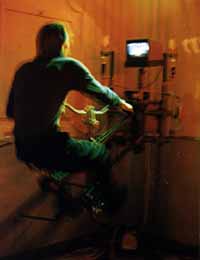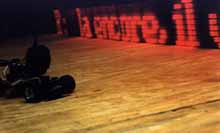| in memoriam JUST MERRIT K U N S T R A D I O : sunday february 11, 2001 - O N A I R and O N L I N E |
|
BLADE RUNNER - a remembrance of just merrit by mark dery ... Just Merit, who died on January 22 from cancer-related complications, was the raffish, real-life embodiment of William Gibson's techno-bricoleurs-a wheelchair-bound machine artist (Just hated the term "artist"!) who reanimated the detritus of industrial culture to savagely funny, often subversive, effect. An Ars Electronica 1996 catalogue bio (badly in need of linguistic debugging) described the Austrian artist's work as "fanning conceptual sparks" into philosophical firestorms. "Using tools of noise [with the group Krueppelschlag] and mechanical sculpture (Gyroscope)," the writer noted, "[Merit] attempts to track down the traces of human bio-mechanical dependencies." Located in Linz, Austria, in the moribund Voest Alpine steelworks (formerly the Hermann Goering Ironworks, a major producer of armaments for the Third Reich), Just's studio-cum-installation, Contained, was both work and workshop, a grungy memorial to the passing of the machine age and a delivery room for hopeful monsters-wondrous additions to the machinic phylum. In an online essay the critic Johannes Domisch likens Just's "hodgepodge/museum" to "a replacement-parts depot of modernism, a genetic data bank of a post-constructivism never consistently carried out. [Merit] administers fragments whose charm lies in their lack of function..." In the artist's own words Contained was "a conglomeration of adventurous ideas, carved out with passionate obsession in the heart of a steelworks, mostly due to me but never borne forward by me alone. For 54 months, this construction of man and material (with considerable wear and tear on both) grew rampant like a malignant tumor at a location which I, bourgeois junior high school boy that I was, took to be at a maximum distance from my family home and my origins." In short, Contained was "the place where life could be felt most directly"-a one-line manifesto reminiscent, ironically, of the Viennese aktionists' desire to resurrect a pre-civilized kinship with the corporeal (blood, death, earth), or of Joseph Beuys' attempts to create an elemental language of fur, fat, and primal muck. In the mid-'90s, Just moved his base of operations from the Voest ironworks to its current location on the Danube, near the Linz harbor. There, he, Tina Auer, and Tim Boykett founded Time's Up, a "laboratory for the creation of experimental situations". The organization's modus operandi, pithily stated on its website, is the short, sharp shock, intended to spark "mindshaping discourse"; Time's Up makes no apologies for "charging the barriers of brain damage." Art as electroconvulsive therapy for unsuspecting bobos. According to the artist John Duncan, the group will continue to administer corrective jolts to the docile and the dozing. "Only hours after the funeral, new plans were being made," he wrote, in a recent e-mail. "Ideas for new projects and practical suggestions of how to implement them were out on the table and under discussion. Which is probably exactly what Just would have wanted." Tim Boykett adds, "Although we will miss Just sorely, we have all learned so much from him that it would be a slap in the face for us to drop any part of the project. One of Just's ongoing concerns was assisting people in hammering their ideas out and helping them get their ideas happening. There [were] simply so many things that he was involved in, and continues to be involved in as he whispers in my ear. And he never forgot to (at least) nibble the hand that feeds." I spent an inspiring evening with Just at Ars Electronica '96, in Linz. He, like Jim Whiting, Chip Flynn, Liz Young, and the rest of the all-star cast of amok tinkerers at that year's Ars, had been banished to the suitably gothic ruins of Voest---for fear, presumably, that their grease-monkey machine art would soil the Armaniwear of the artistocracy, not to mention the prospective corporate underwriters power-lunching at the festival's main hall. Lit by the welding torches of other artists working out the last-minute kinks in their contraptions, Just held forth from his wheelchair, effusing about the works-in-progress and surveying the infernal machines around him with something like paternal pride. Nearby, in the functional part of the steelworks, a colossal crane shuttled back and forth on tracks, a Jurassic Park survivor of the days when heavy industry ruled the earth. Soon, the blue-black stormclouds massing ominously overhead opened their bomb bay doors, sending everyone running for cover. Bit rot has gotten the best of my memories of that day, but I have a blurry (perhaps wishful?) image of Just wheeling himself to shelter, beatific in the midst of the downpour. Just's contribution to Ars '96 (a collaboration with Sam Auinger and Rudolf Heidebrecht) was a propeller equipped with an electric motor and two antique loudspeakers. The motors' struggles against the wind spinning the propeller were converted into acoustic signals and transmitted through the old loudspeakers, artifacts of propaganda campaigns. Located on the site that was slated, in Hitler's dreams, for a future Museum of German Electrical Engineering, Just's installation was, in the words of the Ars catalogue, "a kind of anti-propaganda." It was also a gloriously noisy monument to the slacker hacker ethos---the post-industrial article of faith that work sucks, play rules, and what the world needs now is more pointless, profitless basement tinkering that flips an index finger at revenue streams and return-on-investment. The San Francisco-based machine artist Matt Heckert, who participated in Ars '96, remembers, "I've never met anyone like Just. We first came into contact in 1988. He came over to my place [in San Francisco], we talked for a while, and the next day he asked me if I would make some aluminum wing/blades that would spring out from the wheels on his chair, 'Ya know, like the ones on the chariots in BEN HUR.' At that moment, I realized I was with a different sort of person." Heckert made the blades, mounting them on spring hinges so that Just "could pull a lever and they would spring into position." In another, equally BLADE RUNNER customization, Heckert attached blades from a small hedge-trimmer to one side of Just's wheelchair and grafted a frame from an automatic pistol onto the other side. "He was very put off by people pushing his chair without asking him first, which frequently happened in public places such as airports," notes Heckert. "He wanted them to have to think about what they were doing." Wheelchair activists take heed: This is empowerment-with teeth. Just's visit to Heckert's workshop turned into a one-stop shopping spree. He rounded out his order with the purchase of one of Heckert's hand-held flame-throwers. "Why would anyone want a hand-held flame-thrower?," wonders Heckert. "I only asked him to assure me he wouldn't maim anyone with it and that that wasn't his intention. He did end up using it on stage when performing with Krueppelschlag." A wry critic of our born-again faith in technology, Just celebrated breakdowns and runaways, uselessness and obsolescence. In so doing, he held a lit match to the overblown gas-bag of cyberhype, reminding us that even machines ail, fail, and ultimately grow old and die. Even so, he was no nihilist: His was an iconoclasm with heart---a kinder, gentler irony, in the spirit of Bruno Munari's useless gadgets or Jean Tinguely's suicidal devices. A poet of the Rust-Belt Sublime, he made us see that dead machines and decaying steelworks are the perfumed ruins of our age. He found his own uses for things.Mark Dery Mark Dery is a cultural critic. He edited Flame Wars, a seminal anthology of cybercrit, and wrote Escape Velocity: Cyberculture at the End of the Century (published in German as Cyber: Die Kultur der Zukunft by Volk & Welt). His latest book is the essay collection, The Pyrotechnic Insanitarium: American Culture on the Brink (www.levity.com/markdery). |





